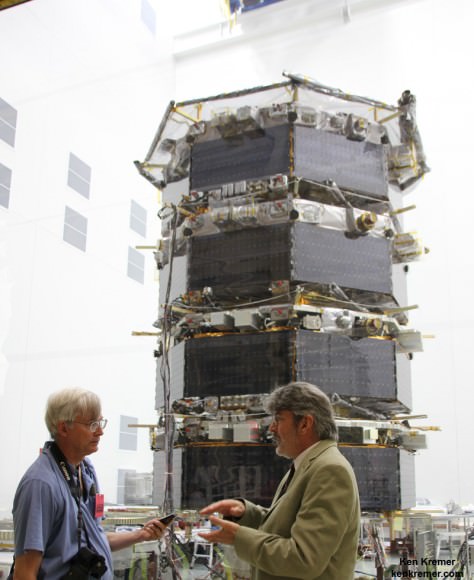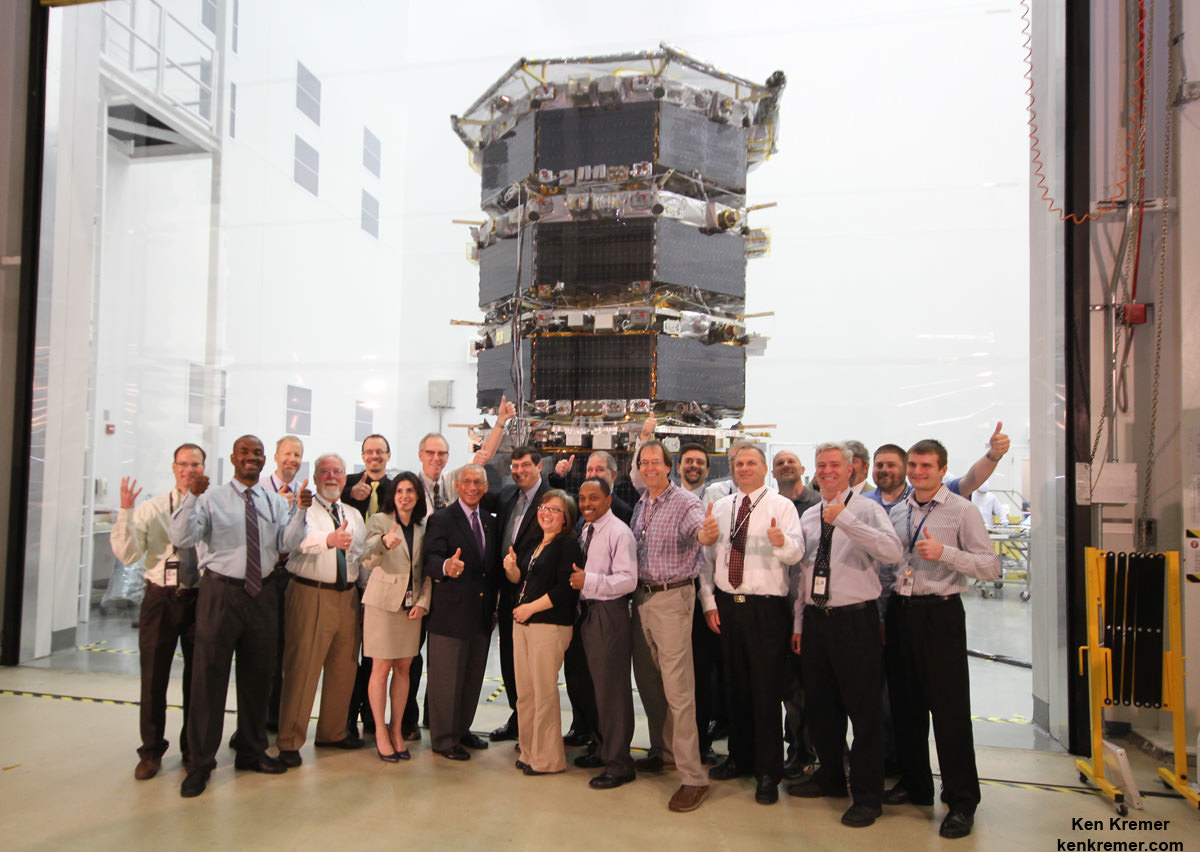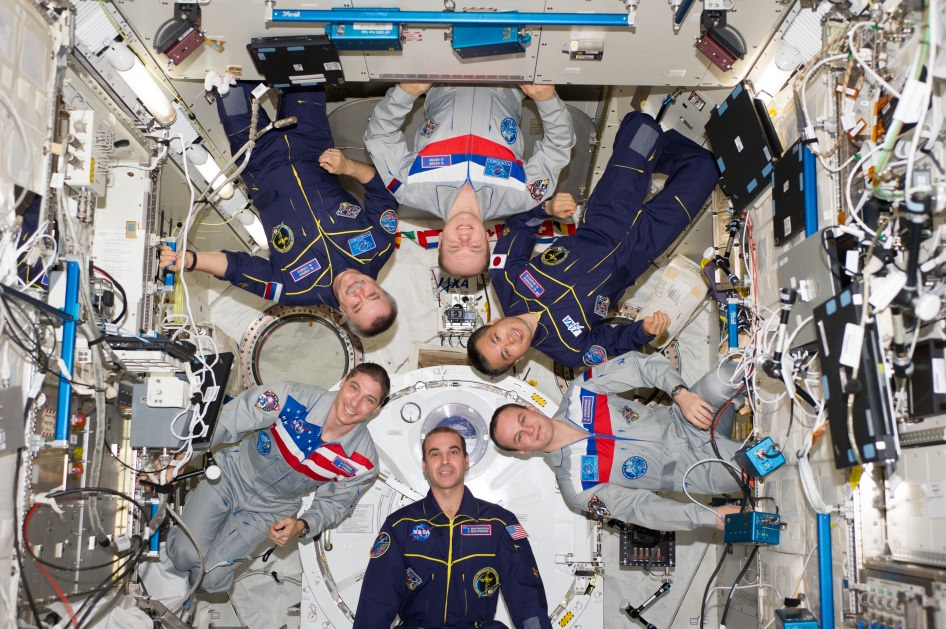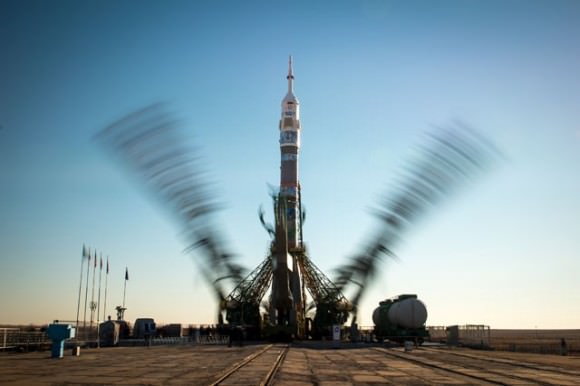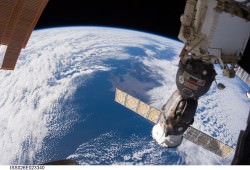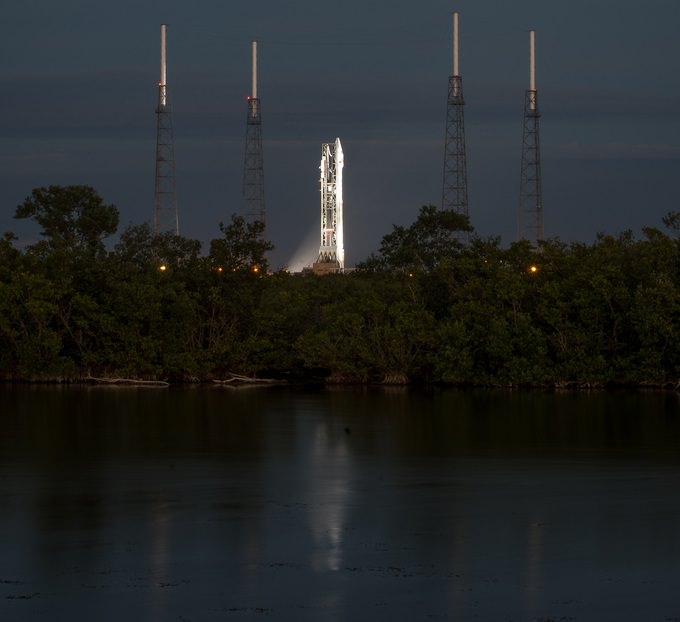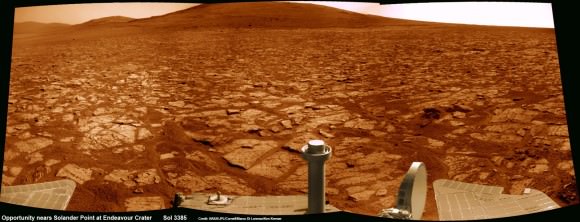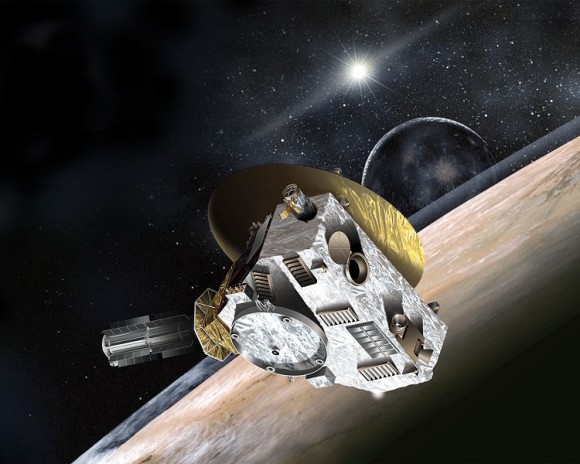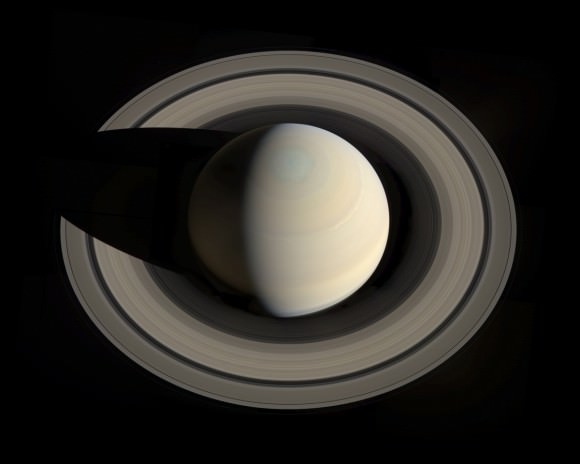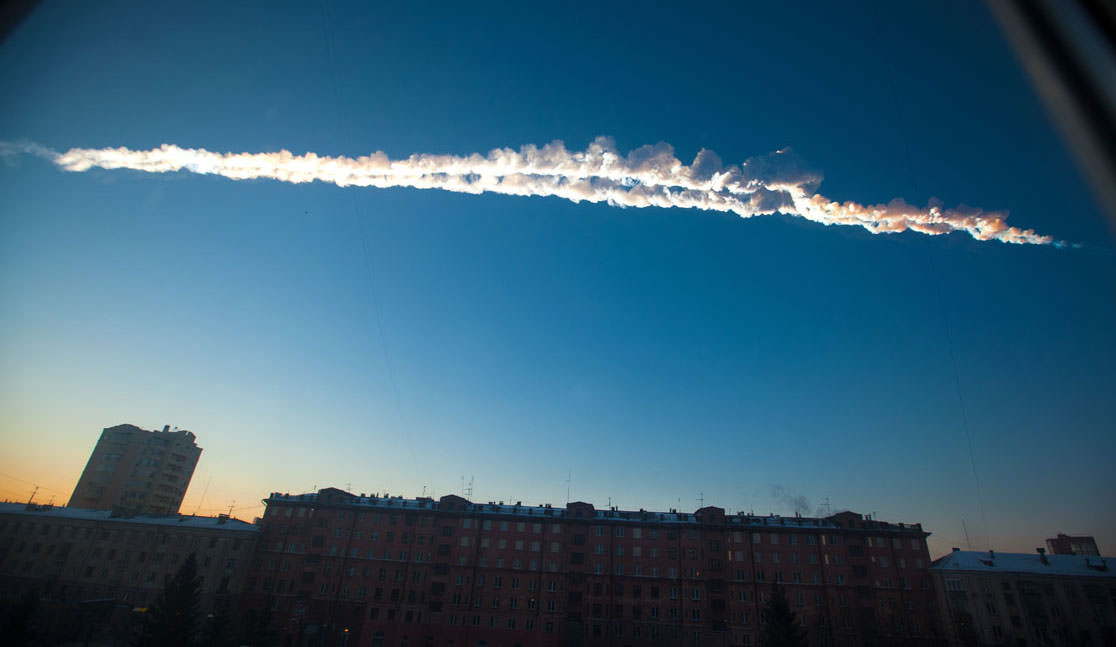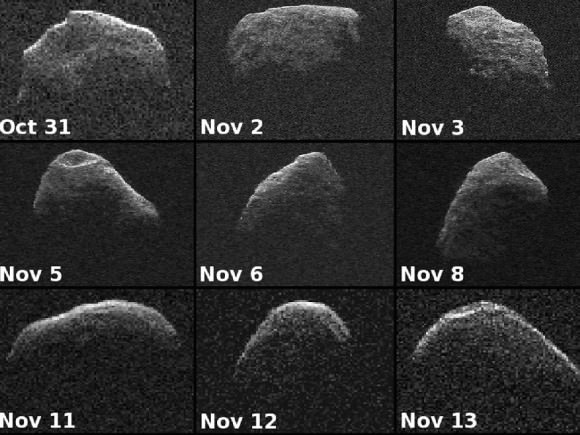NASA Administrator Charles Bolden poses with the agency’s Magnetospheric Multiscale (MMS) spacecraft, mission personnel, Goddard Center Director Chris Scolese and NASA Associate Administrator John Grunsfeld, during visit to the cleanroom at NASA’s Goddard Space Flight Center in Greenbelt, Md., on May 12, 2014. Credit: Ken Kremer- kenkremer.com
Story updated[/caption]
NASA GODDARD SPACE FLIGHT CENTER, MD – NASA’s upcoming Magnetospheric Multiscale (MMS) mission is comprised of a quartet of identically instrumented observatories aimed at providing the first three-dimensional views of a fundamental process in nature known as magnetic reconnection. They were unveiled to greet NASA Administrator Charles Bolden on Monday, May 12, in a rare fully stacked arrangement inside the Goddard cleanroom.
Universe Today was on hand with NASA Administrator Bolden, Science Mission Chief John Grunsfeld and the MMS mission team at Goddard for a first hand inspection and up close look at the 20 foot tall, four spacecraft stacked configuration in the cleanroom and for briefings about the projects fundamental science goals.
“I’m visiting with the MMS team today to find out the status of this mission scheduled to fly early in 2015. It’s one of many projects here at Goddard,” NASA Administrator Bolden told me in an exclusive one-on-one interview at the MMS cleanroom.
“MMS will help us study the phenomena known as magnetic reconnection and help us understand how energy from the sun – magnetic and otherwise – affects our own life here on Earth. MMS will study what effects that process … and how the magnetosphere protects Earth.”
Magnetic reconnection is the process whereby magnetic fields around Earth connect and disconnect while explosively releasing vast amounts of energy.
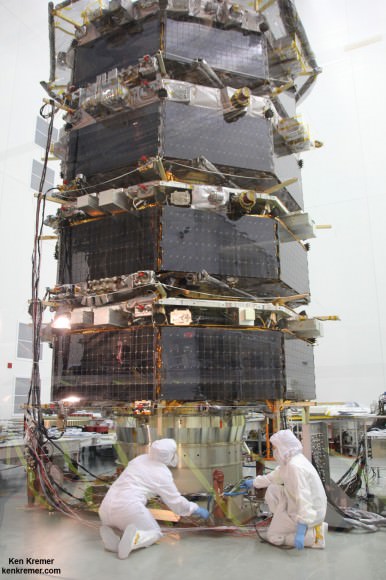
MMS measurements should lead to significant improvements in models for yielding better predictions of space weather and thereby the resulting impacts for life here on Earth as well as for humans aboard the ISS and robotic satellite explorers in orbit and the heavens beyond.
The four identical spacecraft – which are still undergoing testing – were stacked in a rarely seen launch arrangement known affectionately as the “IHOP configuration” – because they look rather like a stack of luscious pancakes.
“MMS is a fundamental heliophysics science mission,” Craig Tooley told me at the MMS cleanroom. Tooley is MMS project manager at NASA Goddard.
“Unlike Hubble that uses remote sensing, MMS is like a flying laboratory ‘in situ’ that will capture events that are the major energy transfer from the sun’s magnetic field into our Earth’s space weather environment and magnetosphere.”
“These are called magnetic reconnection events that pump enormous amounts of energy into the plasma and the fields around Earth. It’s one of the main drivers of space weather and a fundamental physical process that is not very well understood,” Tooley explained.
“The spacecraft were built in-house here at Goddard and just completed vibration testing.”
MMS will launch atop an Atlas V rocket in March 2015 from Space launch Complex 41, Cape Canaveral Air Force Station, Florida.
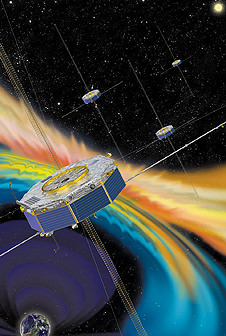
The vibration testing is a major milestone and is conducted to ensure the spacecraft can withstand the most extreme vibration and dynamic loads they will experience and which occurs during liftoff inside the fairing of the Atlas V booster.
MMS is also another highly valuable NASA science mission (along with MAVEN, LADEE and others) which suffered launch delays and increased costs as a result of the US government shutdown last October 2013, Bolden confirmed to Universe Today.
“We ended up slipping beyond the original October 2014 date due to the government shutdown and [the team] being out of work for a couple of weeks. MMS is now scheduled to launch in March 2015,” Bolden told me.
“So then you are at the mercy of the launch provider.”
“The downside to slipping that far is that’s its [MMS] costing more to launch,” Bolden stated.
Each of the Earth orbiting spacecraft is outfitted with 25 science sensors to study the microphysics of three fundamental plasma processes: magnetic reconnection, energetic particle acceleration, and turbulence.
Magnetic reconnection occurs throughout our universe.
“The primary mission will last two years,” Tooley told me.
“Each spacecraft carries about 400 kilograms of fuel. There is a possibility to extend the mission by about a year based on fuel consumption.”
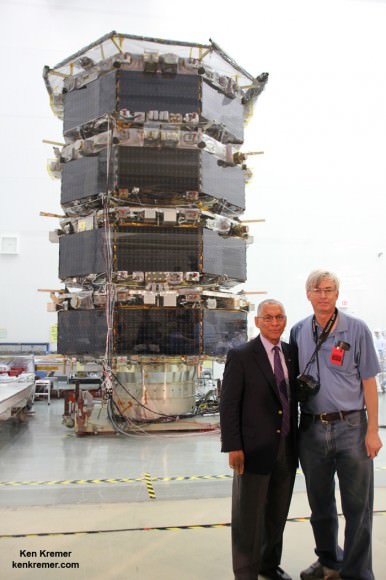
The spacecraft will use the Earth itself as a laboratory to unlock the mysteries of magnetic reconnection – the primary process that transfers energy from the solar wind into Earth’s magnetosphere and is responsible for geomagnetic storms.
“To understand the fundamental physics, they will fly in a pyramid-like formation and capture the magnetic reconnection events in 3-D by flying through them as they happen – that’s why we have 4 spacecraft,” Tooley explained.
“Initially they will be spaced apart by about 10 to 30 kilometers while they fly in a tetrahedron formation and scan with their booms spread out – depending on what the scientists says is the optimal configuration.”
“They fly in a highly elliptical orbit between about 7,000 and 75,000 kilometers altitude during the first half of the mission. Eventually the orbit will be extended out to about 150,000 kilometers.”
The best place to study magnetic reconnection is ‘in situ’ in Earth’s magnetosphere.
This will lead to better predictions of space weather phenomena.
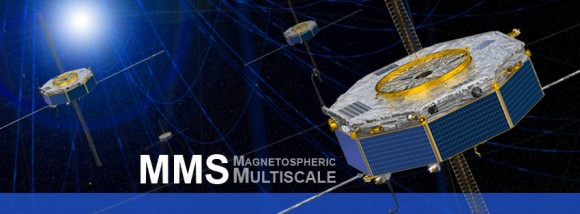
Magnetic reconnection is also believed to help trigger the spectacular aurora known as the Northern or Southern lights.
Stay tuned here for Ken’s continuing MMS, Curiosity, Opportunity, SpaceX, Orbital Sciences, Boeing, Orion, LADEE, MAVEN, MOM, Mars and more planetary and human spaceflight news.
………
Ken’s upcoming presentation: Mercy College, NY, May 19: “Curiosity and the Search for Life on Mars” and “NASA’s Future Crewed Spaceships.”
